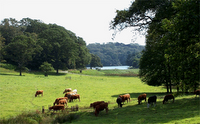A bimble through Trengwainton Gardens
I spent this morning online working on a couple of projects - but by late afternoon I needed a screen break and some fresh air. I decided to make use of my National Trust Volunteer Card which gives me free entry to a number of places closeby. I payed a visit to Trengwainton Gardens just a couple of miles the other side of Penzance. It was a good way to spend a late Sunday afternoon. I took a few pictures to show you around....
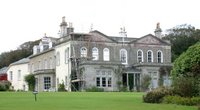 Trengwainton Gardens is a National Trust property that covers nearly 100 acres of shrub garden, bog garden and walled gardens, which overlook Mount's Bay. It climbs gently uphill for a third of a mile following a little stream.
Trengwainton Gardens is a National Trust property that covers nearly 100 acres of shrub garden, bog garden and walled gardens, which overlook Mount's Bay. It climbs gently uphill for a third of a mile following a little stream.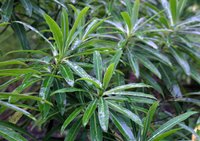 The garden faces due south and has a gentle micro-climate which experiences very few hard frosts. This creates the conditions needed to cultivate the rich collection of rhododendrons, magnolias, camellias and many tender and half-hardy species that cannot be grown in the open anywhere else in England.
The garden faces due south and has a gentle micro-climate which experiences very few hard frosts. This creates the conditions needed to cultivate the rich collection of rhododendrons, magnolias, camellias and many tender and half-hardy species that cannot be grown in the open anywhere else in England.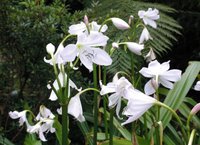 Trengwainton is largely a 20th century creation although there has been a house here at least since the 16th century. Lieutenant Colonel Sir Edward Bolitho, whose family came here in 1857, began work on the garden after he inherited the rambling Victorian house in 1925.
Trengwainton is largely a 20th century creation although there has been a house here at least since the 16th century. Lieutenant Colonel Sir Edward Bolitho, whose family came here in 1857, began work on the garden after he inherited the rambling Victorian house in 1925.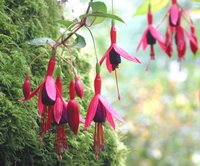 Graham Stuart Thomas wrote that 'Sir Edward gardened, as he used to say, "above the knee", which was his way of informing one that lowly plants did not interest him. In fact he would walk regardlessly through primroses, cyclamens and daffodils to point out to me yet another of his special treasures'.
Graham Stuart Thomas wrote that 'Sir Edward gardened, as he used to say, "above the knee", which was his way of informing one that lowly plants did not interest him. In fact he would walk regardlessly through primroses, cyclamens and daffodils to point out to me yet another of his special treasures'.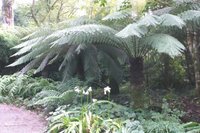 The tortuous paths overhung with Australian Dicksonia tree ferns give it an intimate Jurassic feel. The rhododendrons are ideally suited to the acid soil here.
The tortuous paths overhung with Australian Dicksonia tree ferns give it an intimate Jurassic feel. The rhododendrons are ideally suited to the acid soil here.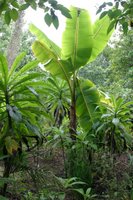 The framework of the garden dates back to the early 19th century when Rose Price, the son of a wealthy West Indian sugar planter, planted a series of tall beech trees and oaks along the line of the stream creating a structure for the garden and giving shelter to the family home; protecting Trengwainton from westerly gales.
The framework of the garden dates back to the early 19th century when Rose Price, the son of a wealthy West Indian sugar planter, planted a series of tall beech trees and oaks along the line of the stream creating a structure for the garden and giving shelter to the family home; protecting Trengwainton from westerly gales.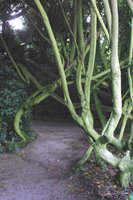 At this time of year the the garden is a soothing warren of deep green that tunnels through feathery bamboo, eucalyptus and fern fronds which line the course of the stream.Lillies and fuchsia punctuate the lush gloom with
At this time of year the the garden is a soothing warren of deep green that tunnels through feathery bamboo, eucalyptus and fern fronds which line the course of the stream.Lillies and fuchsia punctuate the lush gloom with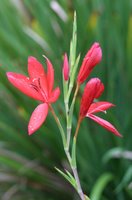 splashes of white red, pink and purple and hydrangea fill patches of the understorey with pale blue.
splashes of white red, pink and purple and hydrangea fill patches of the understorey with pale blue.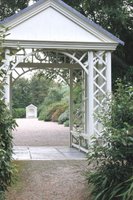 Paths lead up to a terrace and summer houses with stunning views across Mount's Bay to The Lizard.
Paths lead up to a terrace and summer houses with stunning views across Mount's Bay to The Lizard.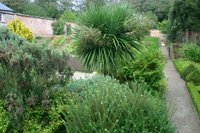 Price used much of his income from the Jamaican plantations to create the unusual walled garden, remodelling the contours of the land, creating terraces, along the south and west facing slopes of the hillside. He used brick, a warmer but more expensive material than the local granite, to build a series of compartments.
Price used much of his income from the Jamaican plantations to create the unusual walled garden, remodelling the contours of the land, creating terraces, along the south and west facing slopes of the hillside. He used brick, a warmer but more expensive material than the local granite, to build a series of compartments. The dividing walls between each separate garden have a steeply sloped bed of banked-up soil on their western side. This is a rare survival of a practice that was common in the late 18th and early 19th centuries. The south- and west-facing slopes receive the full benefit of the sun. Here early crops of vegetables are produced and tender plants cultivated.
The dividing walls between each separate garden have a steeply sloped bed of banked-up soil on their western side. This is a rare survival of a practice that was common in the late 18th and early 19th centuries. The south- and west-facing slopes receive the full benefit of the sun. Here early crops of vegetables are produced and tender plants cultivated.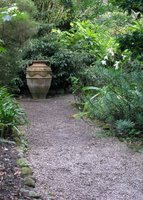 Each compartment has a small lawn, surrounded by borders filled with tender species of shrub and plants including camellias, passionflowers and rhododendrons collected on an expedition to the Himalayas in 1927-8; which Lt. Col. Sir Edward Bolitho partially funded.
Each compartment has a small lawn, surrounded by borders filled with tender species of shrub and plants including camellias, passionflowers and rhododendrons collected on an expedition to the Himalayas in 1927-8; which Lt. Col. Sir Edward Bolitho partially funded. I drove back through Penzance out of curiousity. Despite a plethora of B&Bs , a bingo hall, a pirate souvenir shop and other trappings of a seaside resort town, its does seem to hold onto its original character as a functional port. The view of St Michaels Mount haunts the bay and no doubt makes the recently developed apartments on the front highly desirable real estate.
I drove back through Penzance out of curiousity. Despite a plethora of B&Bs , a bingo hall, a pirate souvenir shop and other trappings of a seaside resort town, its does seem to hold onto its original character as a functional port. The view of St Michaels Mount haunts the bay and no doubt makes the recently developed apartments on the front highly desirable real estate.
We made it into the local paper!
The local paper, The West Briton gave our beach litter survey efforts a shout this week together with those by a group on the neighbouring beach who even organised a SCUBA sweep of the nearshore. The photo is of their group, not ours and deservedly so. See the scan below (click to enlarge). 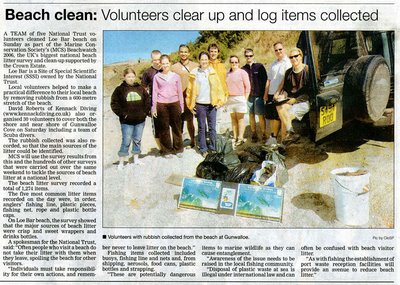 It seems I have been quoted as 'a Spokesman for the National Trust' - so perhaps it was just as well I cleared the press release with the management! The West Briton got their facts a little wrong about our survey results but the gist of the article is ok and hopefully will go some way to raising awareness about the sources of beach pollution and its effects on the local environment without sounding like yet another eco-nag.
It seems I have been quoted as 'a Spokesman for the National Trust' - so perhaps it was just as well I cleared the press release with the management! The West Briton got their facts a little wrong about our survey results but the gist of the article is ok and hopefully will go some way to raising awareness about the sources of beach pollution and its effects on the local environment without sounding like yet another eco-nag.
You can see the online article here.
My Back Garden....
Here are a few more photos of the estate I live on.
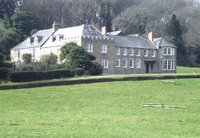 Penrose House is still lived in by the owner, but the grounds now belong to the National Trust and the stables and out-buildings have been converted into a holiday cottage, office space and storage buildings. Part of my job involves mowing its extensive lawns (yawn) but at least this affords a good chance to find toads and watch the buzzards which call constantly overhead....
Penrose House is still lived in by the owner, but the grounds now belong to the National Trust and the stables and out-buildings have been converted into a holiday cottage, office space and storage buildings. Part of my job involves mowing its extensive lawns (yawn) but at least this affords a good chance to find toads and watch the buzzards which call constantly overhead....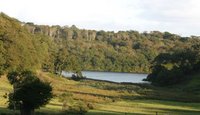 A view of the lake....
A view of the lake....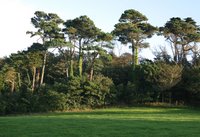 A great collection of mature Macrocarpa Monterey Cypress which lend an impressive structural element to views of the lake shore....Cattle are grazed in the grounds by the reedbeds....
A great collection of mature Macrocarpa Monterey Cypress which lend an impressive structural element to views of the lake shore....Cattle are grazed in the grounds by the reedbeds....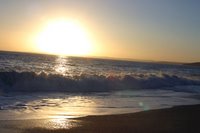 The beach at the seaward end of the estate is part of a 4 mile stretch from Porthleven in the north to Gunwalloe Fishing Cove in the south. This beach has been the scene of many shipwrecks in the past. Loe Bar is composed of small stones, some semi-precious, and separates an inland pool from the sea.At Porthleven, famous for its crab and lobsters, there is a small sandy beach below the pier and opposite the channel. From here southwards, are areas of rock and sand until you reach the Bar. There are plenty of grassy areas on which to laze, but the beach shelves steeply causing whats known as a 'reef break' and due to strong currents is not suitable for swimming.
The beach at the seaward end of the estate is part of a 4 mile stretch from Porthleven in the north to Gunwalloe Fishing Cove in the south. This beach has been the scene of many shipwrecks in the past. Loe Bar is composed of small stones, some semi-precious, and separates an inland pool from the sea.At Porthleven, famous for its crab and lobsters, there is a small sandy beach below the pier and opposite the channel. From here southwards, are areas of rock and sand until you reach the Bar. There are plenty of grassy areas on which to laze, but the beach shelves steeply causing whats known as a 'reef break' and due to strong currents is not suitable for swimming.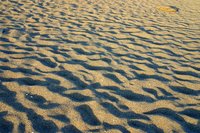 I've spent several evenings already watching the sun go down on the Bar. There's a tranquil warm tone to the sand and rocks in the last hour of daylight. Each time I've been there, if the wind is not too strong, a small flock of ringed plover will arrive and browse the shingle for flies, darting this way and that to snatch them from the weed.
I've spent several evenings already watching the sun go down on the Bar. There's a tranquil warm tone to the sand and rocks in the last hour of daylight. Each time I've been there, if the wind is not too strong, a small flock of ringed plover will arrive and browse the shingle for flies, darting this way and that to snatch them from the weed.
The Results are in...
Seeing as I had to compile the Beachwatch survey data for the MCS, it wasn't much extra effort to summarize it here. The two charts you see here can be viewed as larger images if you click on them. The first "% Material Type" gives a breakdown of general category of material as a percentage of the total number of items found. Plastics clearly dominate and were made up mainly of short pieces of fishing line, small fragments of plastic, pieces of fishing net and nylon rope.
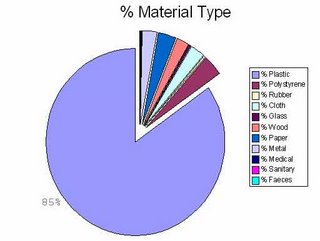
"% Estimated Source" is a measure of the percentage of the total number of items categorized by likely source based on item type. There is some overlap between 'beach visitors' and 'fishing items' where angling line may have come from beach fishing - but the convention the MCS adopts is to group all fishing items together.
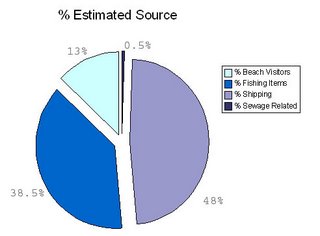
Out of a total number of 1269 items found, the highest numbers in descending order were 407 pieces of fishing line; 259 plastic pieces 1-50cm across; 112 plastic pieces less than 1cm across; 78 pieces of fishing net less than 50cm across; 73 pieces of nylon rope; 47 plastic caps and lids; 34 pieces of cloth/string; 27 wood pieces; 25 pieces of foam/sponge; 24 plastic wrappers; 22 pieces of paper; 19 pieces of plastic cutlery/straws/trays; 17 plastic bottles; 16 plastic bags; 16 polystyrene pieces less than 50cm across; 14 drink cans; 11 cigarette stubs....
Why post all this information here? You may have taken part in a Beachwatch yourself this year and want to compare results. We sampled 400m of beach 40m wide, 5m from the surf to the high water mark (strand line). We began the survey 2 hours before high tide and continued as the tide came in although the MCS recommends that litter surveys are recorded around 1-2 hours after high tide to get a better measure of what has washed up on the previous tide. You may survey your local beach regularly or you may have studied coastal pollution and have a method for doing this. I'd be interested to find out.
Has the MCS been active in your area? Has environmental lobbying caused a change in industrial practice or beach use near you e.g. dumping at sea; litter signs; provision of bins. I'd be interetsed to know whether beach surveys are making a difference. What is the scourge of your beach? Maybe its sewage outfall or disposable barbeques and fires. Ours is clearly fishing waste and plastics.
Beachwatch!
 Wouldn't it be good if you could take a snap shot of all the litter that washed up on the UK coast, count and categorize it so that you could gain a picture of where it concentrates, how much there is and what it consists of. You might then have some of the information you need to begin to work out where it comes from and to ultimately do something about it. That's what the Marine Conservation Society in the UK (MCSUK) has been doing since 1993 to help target specific sources of litter and influence government policy and industry practices. Beachwatch is an annual nation-wide beach clean-up and litter survey. It takes place once every year, over the third weekend of September.
Wouldn't it be good if you could take a snap shot of all the litter that washed up on the UK coast, count and categorize it so that you could gain a picture of where it concentrates, how much there is and what it consists of. You might then have some of the information you need to begin to work out where it comes from and to ultimately do something about it. That's what the Marine Conservation Society in the UK (MCSUK) has been doing since 1993 to help target specific sources of litter and influence government policy and industry practices. Beachwatch is an annual nation-wide beach clean-up and litter survey. It takes place once every year, over the third weekend of September.
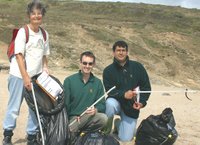 I was assigned our local beach, Loe Bar, for a Sunday morning's litter-picking and was joined by Len, Davide, Heather (a local volunteer) and Edwina from Austria. We categorized Davide and Edwina under 'foreign objects'. You can see Heather, me and Davide in the picture brandishing clipboards and litter-pickers.
I was assigned our local beach, Loe Bar, for a Sunday morning's litter-picking and was joined by Len, Davide, Heather (a local volunteer) and Edwina from Austria. We categorized Davide and Edwina under 'foreign objects'. You can see Heather, me and Davide in the picture brandishing clipboards and litter-pickers.
I phoned Noel Perry, the Community Editor of the West Briton yesterday to let him know what we were up to. He seemed pretty interested and suggested I drop him a line. The MCS send Beachwatchers a media pack which they can use to promote marine conseravion in their area. I'll fire Noel an email with the press release info and a photo and see if we can get a conservation article into print for next week's paper. We might be in danger of being overshadowed by the excellent effort yesterday on Gunwalloe Fishing Cove made by David Roberts of Kennack Diving near Helston. He and 30 other volunteers not only combed the shore but organised a SCUBA sweep of the near shore as well.

The main hazards to be aware of apart from the sea itself were any glass fragments, sharp metal or needles. Luckily we found none. The vast majority of waste seemed to be from fishing line and nets. All that remains now is to tally up the data and send off the completed forms to MCSUK who will analyse the results and try to identify significant patterns regionally and nationally.
Loe Bar is an unusual and treacherous stretch of coastal vegetated shingle that separates the freshwater of Loe Pool from the sea. The mysterious Loe Pool is the fabled resting place of King Arthurs sword Excalibur. You can find it here. English Nature have designated the coastal lagoon of Loe Pool and the Loe Bar beach as a Site of Special Scientific Interest (SSSI). The Loe Pool SSSI as it is known, covers nearly 130ha and includes the largest freshwater lagoon in Cornwall. Both the pool and the shingle bar provide habitat that is scarce elsewhere in the county.
The pool supports rare aquatic plants such as Six-stamened Waterwort, Perfoliate Pondweed, Shoreweed, Horned Pondweed and Amphibious Bistort. On the bar you can find Sea Holly, Sea Fern-grass, Yellow Horned Poppy, Sea Sandwort, Sea Mayweed and a real rarity - Strapwort. Loe Pool is an important site for as many as 1,200 wildfowl in winter including about 80 species. Nationally important numbers of Shoveler have been recorded as have regionally important counts of Teal and high counts for Pochard, Tufted Duck, Mallard, Goldeneye, Gadwall and Coot. Little holes excavated a metre below the cliff edge are a tell-tale sign that Sand Martin breed here in Summer. There is a locally important presence of some 20 pairs.
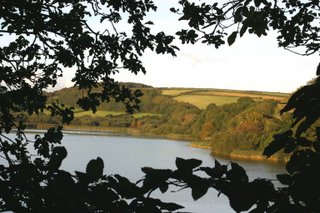
Many rare invertebrates live in the sediments of the pool because of its rich nutrient status and 9 species of dragonfly and damselfly can be found including the Keeled Skimmer. Rare beetles, wasps and a woodlouse found nowhere else in the county have also been noted here.
Perhaps the most exciting rarity on the bar is the only known population of the Cornish subspecies of Sandhill Rustic Moth. I was fortunate enough to have a chance encounter with local lepidopteran expert Adrian Spalding returning from the bar last week. Adrian was happy to open up a file of information based on over a decade's fieldwork on the bar aimed at understanding why this Sandhill Rustic Moth occurs where it does. Adrian explained that the moth had the ability to withstand baking hot daytime temperatures in direct sunlight on the shingle where it remains concealed from predators by its cryptic wing markings. Its distribution shows a strong association with its food plant Sand Couch Grass which is highly saline tolerant. The most suprising attribute of this secretive insect is its apparent readiness to submerge itself completely in seawater for over an hour at a time - an underwater moth! This seems to be a behavioural adaptation to periodic flooding of its habitat by sea water. These specialist factors seem to combine to give this moth the competitive advantage in the vegetated coastal shingle found on the bar and could account for its rarity.
A new chapter....
It's late. My mug of tea has gone cold and I am fixed by the wary, unblinking stare of a delicately formed nocturnal wasp who has mistaken the papery globe of my room light for a full Cornish moon. Judging from its prominent ovipositor, I guess it is a she; and I am reliably informed by my 'Complete Guide to British Insects' that her name is Netelia. It's a name I'd associate with a Russian ballerina - feminine, delicate, elegant.
I arrived twelve days ago. It hardly seems like two or three. The cottage is homely with a wood burner and a buddha in the back garden. The grounds of the estate fall away under a deeply shaded canopy of turkey oak onto the shore of a large freshwater lake fringed with reedbeds and sundered from the sea by a shingle spit. The coast is crenelated by warm rocky coves and the air is soft.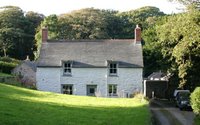
I have two housemates, Len, a wirey, red-bearded, well-travelled, poetry-penning buddhist who has been here 6 months already and who extended a warm welcome to me on my arrival; and Davide (pron. Daviday) a large lad and ex-accountant from a place near Turin in Italy with a passion for football and an insatiable appetite for extending his English vocabulary and who claims to have lost no less than 13kg in the last 2 months since he quit the desk job and came to England. All three of us are this season's voluntary wardens for the National Trust in this area and share Keeper's Cottage, the accommodation provided by the Trust in return for our full-time work maintaining the estates in the local area. Our remit extends to the Godolphin and Penrose Estates.
 The last two weeks have been full of new experiences I'll relate in coming entries. For now, I'll sign off, but this evening I am encouraged to think that unlike Netty my desk-side companion who was seduced tonight by a false light, false goals are behind me and a new chapter is opening.
The last two weeks have been full of new experiences I'll relate in coming entries. For now, I'll sign off, but this evening I am encouraged to think that unlike Netty my desk-side companion who was seduced tonight by a false light, false goals are behind me and a new chapter is opening.
 Trengwainton Gardens is a National Trust property that covers nearly 100 acres of shrub garden, bog garden and walled gardens, which overlook Mount's Bay. It climbs gently uphill for a third of a mile following a little stream.
Trengwainton Gardens is a National Trust property that covers nearly 100 acres of shrub garden, bog garden and walled gardens, which overlook Mount's Bay. It climbs gently uphill for a third of a mile following a little stream.
 Trengwainton is largely a 20th century creation although there has been a house here at least since the 16th century. Lieutenant Colonel Sir Edward Bolitho, whose family came here in 1857, began work on the garden after he inherited the rambling Victorian house in 1925.
Trengwainton is largely a 20th century creation although there has been a house here at least since the 16th century. Lieutenant Colonel Sir Edward Bolitho, whose family came here in 1857, began work on the garden after he inherited the rambling Victorian house in 1925. Graham Stuart Thomas wrote that 'Sir Edward gardened, as he used to say, "above the knee", which was his way of informing one that lowly plants did not interest him. In fact he would walk regardlessly through primroses, cyclamens and daffodils to point out to me yet another of his special treasures'.
Graham Stuart Thomas wrote that 'Sir Edward gardened, as he used to say, "above the knee", which was his way of informing one that lowly plants did not interest him. In fact he would walk regardlessly through primroses, cyclamens and daffodils to point out to me yet another of his special treasures'. The tortuous paths overhung with Australian Dicksonia tree ferns give it an intimate Jurassic feel. The rhododendrons are ideally suited to the acid soil here.
The tortuous paths overhung with Australian Dicksonia tree ferns give it an intimate Jurassic feel. The rhododendrons are ideally suited to the acid soil here.
 At this time of year the the garden is a soothing warren of deep green that tunnels through feathery bamboo, eucalyptus and fern fronds which line the course of the stream.
At this time of year the the garden is a soothing warren of deep green that tunnels through feathery bamboo, eucalyptus and fern fronds which line the course of the stream. splashes of white red, pink and purple and hydrangea fill patches of the understorey with pale blue.
splashes of white red, pink and purple and hydrangea fill patches of the understorey with pale blue. Paths lead up to a terrace and summer houses with stunning views across Mount's Bay to The Lizard.
Paths lead up to a terrace and summer houses with stunning views across Mount's Bay to The Lizard. Price used much of his income from the Jamaican plantations to create the unusual walled garden, remodelling the contours of the land, creating terraces, along the south and west facing slopes of the hillside. He used brick, a warmer but more expensive material than the local granite, to build a series of compartments.
Price used much of his income from the Jamaican plantations to create the unusual walled garden, remodelling the contours of the land, creating terraces, along the south and west facing slopes of the hillside. He used brick, a warmer but more expensive material than the local granite, to build a series of compartments. The dividing walls between each separate garden have a steeply sloped bed of banked-up soil on their western side. This is a rare survival of a practice that was common in the late 18th and early 19th centuries. The south- and west-facing slopes receive the full benefit of the sun. Here early crops of vegetables are produced and tender plants cultivated.
The dividing walls between each separate garden have a steeply sloped bed of banked-up soil on their western side. This is a rare survival of a practice that was common in the late 18th and early 19th centuries. The south- and west-facing slopes receive the full benefit of the sun. Here early crops of vegetables are produced and tender plants cultivated. Each compartment has a small lawn, surrounded by borders filled with tender species of shrub and plants including camellias, passionflowers and rhododendrons collected on an expedition to the Himalayas in 1927-8; which Lt. Col. Sir Edward Bolitho partially funded.
Each compartment has a small lawn, surrounded by borders filled with tender species of shrub and plants including camellias, passionflowers and rhododendrons collected on an expedition to the Himalayas in 1927-8; which Lt. Col. Sir Edward Bolitho partially funded. I drove back through Penzance out of curiousity. Despite a plethora of B&Bs , a bingo hall, a pirate souvenir shop and other trappings of a seaside resort town, its does seem to hold onto its original character as a functional port. The view of St Michaels Mount haunts the bay and no doubt makes the recently developed apartments on the front highly desirable real estate.
I drove back through Penzance out of curiousity. Despite a plethora of B&Bs , a bingo hall, a pirate souvenir shop and other trappings of a seaside resort town, its does seem to hold onto its original character as a functional port. The view of St Michaels Mount haunts the bay and no doubt makes the recently developed apartments on the front highly desirable real estate.




